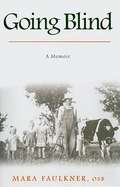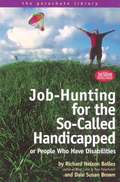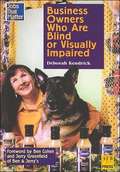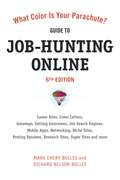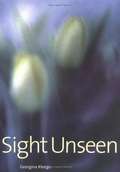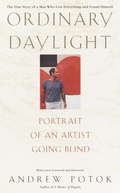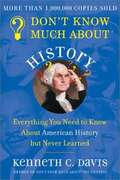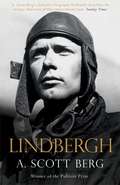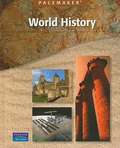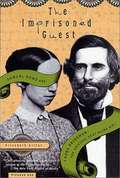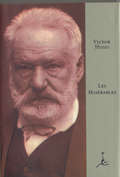Special Collections
Hadley School for the Blind Collection
Description: Recommended Reads for students at Hadley School for the Blind #disability #adults
- Table View
- List View
Going Blind
by Mara FaulknerMara Faulkner grew up in a family shaped by Irish ancestry, a close-to-the-bone existence in rural North Dakota, and the secret of her father's blindness--along with the silence and shame surrounding it. Dennis Faulkner had retinitis pigmentosa, a genetic disease that gradually blinded him and one that may blind many members of his family, including the author.
Moving and insightful, Going Blind explores blindness in its many Permutations-within the context of the author's family, more broadly, as a disability marked by misconceptions, and as a widely used cultural metaphor. Mara Faulkner delicately weaves her family's story into an analysis of the roots and ramifications of the various metaphorical meanings of blindness, touching of the Catholic Church of the 1940s, and 1950s, Japanese internment, the Germans from Russia who dominated her hometown, and the experiences of Native people in North Dakota.
Neither sentimental nor dispassionate, the author asks whether it's possible to find gifts when sight is lost.
Job-Hunting for the So-Called Handicapped (Second Edition)
by Richard Nelson Bolles and Dale S. BrownRichard Bolles' What Color is your Parachute? has helped millions of readers find their path in life, and now his creative approach to job-hunting is brought to bear on the specific challenges faced by job hunters with disabilities. In Job-Hunting for the So-Called Handicapped, Bolles and Dale Susan Brown guide readers through the often-frustrating, but ultimately rewarding process of securing independence in their lives and personal satisfaction in their careers. The authors begin by demystifying the intricacies of the ADA, describing in clear terms what the act does and does not guarantee disabled job hunters, and then move on to job-hunting strategies tailored specifically to people with disabilities.
My Path Leads to Tibet
by Sabriye TenberkenDefying everyone's advice, armed only with her rudimentary knowledge of Chinese and Tibetan, Sabriye Tenberken set out to do something about the appalling condition of the Tibetan blind, who she learned had been abandoned by society and left to die. Traveling on horseback throughout the country, she sought them out, devised a Braille alphabet in Tibetan, equipped her charges with canes for the first time, and set up a school for the blind. Her efforts were crowned with such success that hundreds of young blind Tibetans, instilled with a newfound pride and an education, have now become self-supporting. A tale that will leave no reader unmoved, it demonstrates anew the power of the positive spirit to overcome the most daunting odds.
No Limits
by Harry C. Cordellos and Janet WellsImagine a blind person water-skiing, golfing, running a marathon, and even diving. Harry Cordello did not let his blindness limit his activity. Instead he asked himself "Why not"?
White Coat, White Cane
by David Hartman and Bernard AsbellThe woman's arthritic fingers feel gnarled and crooked, her knees lumpy rocks. But I can detect no swelling, so I press here, there, trying to rouse an inflamed spot. "What are you doing"she challenges. "You're blind!"
"I'm examining you. Haven't you ever been examined by a blind doctor before?"
She refuses to be humored. "That's silly. What can a blind doctor do?"
"I'm not sure, but we're going to find out..."
When David Hartman, blind since the age of eight, announced his intention to become a doctor, the reactions ranged from sympathy to ridicule. How could he diagnose his patients? Examine them, except by touch? Look through a microscope? Even understand what was being described?
The battle lines were drawn: David and his family on one side, the schools and society on the other. But with an incredible strength of purpose, David Hartman went on to become the first blind person in over 100 years to enter medical school. What is it like to adjust to a world of darkness? David Hartman lets us know bluntly, with real emotion, insight, and humor. He had to relearn the simplest things. He had to overcome mental obstacles that were at times more formidable than the physical ones. Yet he was determined to reach beyond his difficulties to fulfill an impossible dream.
His teachers were helpful, hostile, embarrassed, unsure-and in medical school he had to work twice as hard. The work had to be read to him or translated into Braille. Often he had to rely on a sighted person to confirm his diagnosis, and he needed a nurse to read the patients' charts to him. But he utilized all his other senses to achieve his greatest desire: helping to heal. His journey is a moving and inspirational story for us all.
Business Owners Who Are Blind or Visually Impaired
by Deborah KendrickThe second title in the exciting Jobs That Matter series written by an award-winning blind journalist, Business Owners Who Are Blind or Visually Impaired demonstrates the wide range of careers and talents that can be pursued by persons with visual impairments. Each profile features a successful individual who has accomplished his or her dream of business ownership and who shares important insights. From a lawyer and an accountant to a florist and a gourmet cook, the range of engaging stories told will inspire young adults with visual impairments and the parents, teachers, and counselors who advise them.
American Government Pacemaker (3rd Edition)
by Jane PetlinksiThis book will give you a basic understanding of the system of government of the United States. First you will learn about the roots of the government. You will discover that the United States system reflects some principles of government that are thousands of years old. Then you will learn how federal, state, and local governments work, independently and cooperatively, for the good of all citizens. Perhaps most importantly, you will learn about the freedoms and rights guaranteed to all United States citizens.
What Color Is Your Parachute? Guide to Job-Hunting Online (Sixth Edition)
by Richard Nelson Bolles and Mark Emery BollesBefore you start your Internet job-hunt, there are some things that you must know, like: * Why are job sites like Monster and CareerBuilder so stunningly ineffective? * What can you do to make sure your resumes survive the elimination process? * How do you find the information that search engines like Google can't? * How can you tell the difference between a genuinely helpful job board, and a website designed only to collect resumes? * When are hobby forums more helpful than business networking sites? * When is the Internet not helpful when job-hunting? * What is the fatal flaw of all social networking sites? The Guide to Job-Hunting Online, 6th Edition, not only answers these questions and many more, but shows you how to comprehensively and effectively use the Internet for all aspects of your job-hunt. This companion to What Color Is Your Parachute?, the best-selling job-hunting book in the world, has been completely rewritten for our changing times and includes hundreds of updated website recommendations and descriptions. The Guide to Job-Hunting Online shows you how to quickly find the data that will be most helpful to you, how to identify and research the places where you will most enjoy working, how to leverage the power of social networking sites, and how to use your Internet time most effectively, avoiding the common pitfalls and setting you up for success.
Sight Unseen
by Georgina KleegeThis elegantly written book offers an unexpected and unprecidented accout of blindness and sight. Legally blind since the age of eleven, Georgina Kleege draws on her experiences to offer a detailed testimony of visual impairment - both her own view of the world and the world's view of the blind. "I hope to turn the reader's gaze outward, to say not only 'Here's what I see' but also "here's what you see,' to show what's both unique and universal," Kleege writes.
Kleege describes the negative social status of the blind, analyzes stereotypes of the blind hat have been perpetuated by movies, and discusses how blindness has been portrayed in literature. She vividly conveys the visual experience of someone with severely impaired sight and explains what she cannot (and how her inability to achieve eye contact - in a society that prizes that form of connection - has affected her).
Finally she tells of the various ways she reads, and the freedom she felt when she stopped concealing her blindness and acquired skills, such as reading braille, as part of a new blind identity.
Ordinary Daylight
by Andrew PotokAndrew Potok is an intense, vigorous, sensual man--and a gifted painter. Then, passing forty, he rapidly begins to go blind from an inherited eye disease, retinitis pigmentosa. Depressed and angry, he rages at the losses that are eradicating his life as an artist, his sources of pleasure, his competence as a man. He hates himself for becoming blind. But as he will ultimately discover, and as this remarkable memoir recounts, it is not the end of the world. It is the beginning.
his the story of Potok's remarkable odyssey out of despair. He attempts to come to terms with his condition: learning skills for the newly blind, dealing with freakish encounters with the medical establishment, going to London for a promised cure through a bizarre and painful "therapy" of bee stings. He wrestles with the anguish of knowing that his daughter has inherited the same disease that is stealing his own eyesight. And then, as he edges ever closer to complete blindness, there comes the day when he recognizes that the exhilaration he once found in the mix of paint and canvas, hand and eye, he has begun to find in words.
By turns fierce, blunt, sexy, and uproariously funny, Andrew Potok's memoir of his journey is as shatteringly frank as it is triumphant.
Stars Come out Within
by Jean LittleIn this sequel to "Little by Little," (also available on Bookshare) Ms. Little shares her struggles, her hard-won successes, her sorrows and her joys. She becomes a published writer, earns awards for her books, grapples with becoming blind, acquires a talking computer, obtains a Seeing Eye dog, travels a bit, and introduces us to authors who delight her. A story beautifully written and warmly told. A fine book for a book report. An embossed braille copy should read well.
Surpassing Expectations
by Lawrence ScaddenThe booktells the story of the authors life without sight,a memoir that recalls the activities that brought him international acclaim as a scientist, policymaker, and advocate.
Don't Know Much About History
by Kenneth C. DavisThe author describes the rollicking ride through more than 500 years of American history. In this updated edition of the classic anti-textbook, he debunks, recounts, and serves up the real story behind the myths and fallacies of American history.
The Imprisoned Guest
by Elisabeth GitterDid you ever wonder what inspired Helen Keller's mother to have such high hopes for her daughter? The answer is Laura Bridgman, the original deaf-blind girl who inspired Charles Darwin to visit her and also write about her in American Notes.
Foundations of Low Vision
by Jane N. Erin and Anne CornThe editors and contributors of this book provide an examination of the clinical and functional perspectives of low vision. New to the second edition are revisions in all areas, state-of-the-art technology, a reorganization to examine in more depth the needs of individuals in different age ranges, new charts, certification requirements for low vision therapists, and information on pathology, early development, and discussion of the relationship between the vision and the brain.
Hong Kong Life & Culture
by Emily L. Y. ChanHere is a concise guide with information about living in Hong Kong. There are even tips about gift giving, gift receiving, tipping, dining, funerals and weddings.
Encore
by Richard KinneyA small book of poems written by Richard Kinney dedicated to "my friends" and copyrighted in 1954
Pacemaker General Science (3rd edition)
by Globe FearonThis book teaches about three different areas of science: life science, physical science, and earth science. You will learn about living things, including plants and animals. You will study motion and forces, such as those that affect a thrown baseball and a roller coaster racing along on its track. You will come to better understand the features of the Earth, including its oceans and moon. When you finish this book, you will be prepared to continue studying any field of science you choose. You will be on the road to success in the 21st century.
More Than Meets the Eye
by Derek Gill and Joan BrockJoan Brock was a teacher at an Iowa school for the blind when her life was nearly prefect. Then tragedy struck not once but twice. Most people would have wallowed in self pity and asked Why me? This courageous woman decided to face her challenges and ask Why not me? Her story is to say the very least inspirational.
A Hand Well Played
by Anne Hobson FreemanAn engaging and inspirational biography of Jim Wheat, a blind investment banker who built a prominent brokerage firm.
Les Misérables
by Victor Hugo and Charles E. WilbourLes Miserables is the great epic masterpiece of the mid-nineteenth century. Begun in 1845, the year Louis Philippe conferred a peerage and a lifetime seat in the Senate upon Victor Hugo, it was completed when the author was living in exile in the Channel Islands. Les Miserables is a product as well as a document of the political, social, and religious upheaval that followed the Napoleonic Wars and Europe's great democratic revolutions. The story is centered on Jean Valjean, a peasant who enters the novel a hardened criminal after nineteen years spent in prison for stealing a loaf of bread for the starving children of his sister. The path of Valjean's last twenty-five years, leading from the French provinces to the battlefield of Waterloo and the ramparts of Paris during the Uprising of 1832, introduces us to secret societies of revolutionaries and the vast world of the French lower classes. Jean Valjean's flight from the police agent Javert--the prototype of over a hundred years of fictional detectives--culminates in one of the most famous scenes in all literature, the chase through the sewers of Paris. Les Miserables sold out its large first printing in twenty-four hours and has remained enormously popular. This edition is the classic English translation of Hugo's friend Charles Wilbour, which appeared the same year the novel was published in France.
